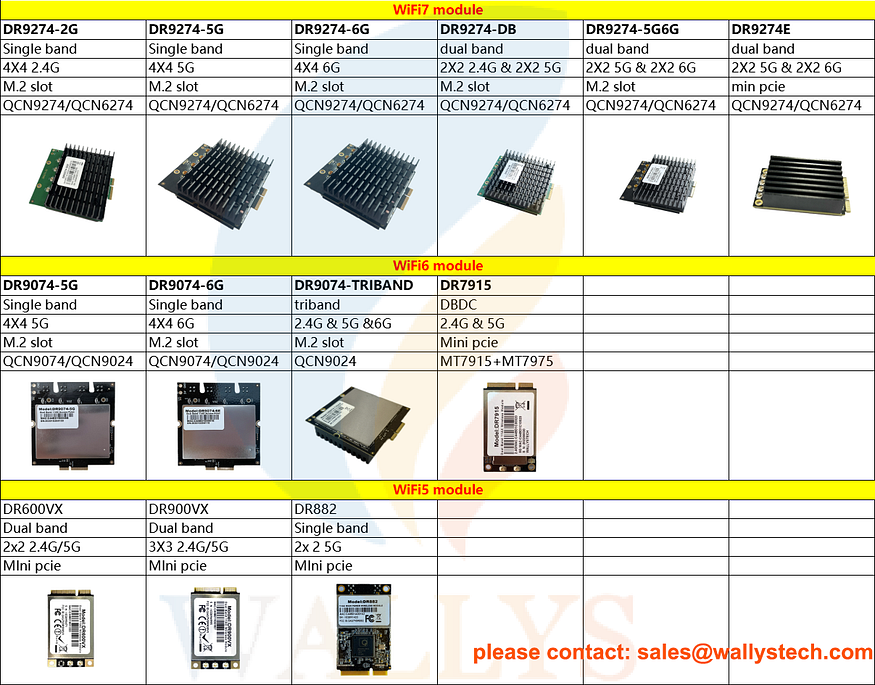As wireless communication technology evolves, WiFi 6 (802.11ax) has become the mainstream standard for next-generation high-performance wireless access. Qualcomm, a leader in wireless chipsets, offers a broad lineup of WiFi 6 solutions, among which QCN9074 and QCN9024 are two widely adopted main wireless chips used in high-performance routers, enterprise-grade access points (APs), and industrial networking devices.
This article presents a comprehensive comparison of these two chips from multiple perspectives, including core specifications, application scenarios, feature sets, platform compatibility, and use cases.

1. Core Specifications Comparison
ParameterQCN9074QCN9024Standard SupportIEEE 802.11a/b/g/n/ac/ax (WiFi 6)IEEE 802.11a/b/g/n/ac/ax (WiFi 6)Frequency Bands2.4GHz, 5GHz (6GHz capable but disabled)2.4GHz, 5GHzSpatial Streams4x4 MU-MIMO4x4 MU-MIMOModulation1024-QAM1024-QAMChannel BandwidthUp to 160MHzUp to 160MHzPHY RateUp to 4.8GbpsUp to 4.8GbpsInterfacePCIe 3.0PCIe 3.0BeamformingYesYesOFDMA / MU-MIMOUplink & DownlinkUplink & DownlinkTarget ApplicationsHigh-end enterprise, outdoor APs, industrial devicesCommercial-grade, home or mid-tier enterprise APsOpenWRT SupportStrong and well-maintainedPartially supported depending on vendorMulti-band CoordinationStrong, ideal for dense deploymentsModerate, suitable for typical deployments

2. Architecture and Design Differences
QCN9074
- Designed as Qualcomm’s flagship WiFi 6 radio chip, aimed at high-performance networking.
- Supports advanced 4x4@5G MIMO configurations, ideal for enterprise APs, outdoor mesh systems, and industrial gateways.
- Commonly paired with IPQ807x/IPQ957x series SoCs, or deployed on x86 platforms via PCIe cards.
- Some variants are hardware-ready for 6GHz (though not enabled), allowing future upgrades.
QCN9024
- A mainstream WiFi 6 solution for mid-tier markets, offering a cost-performance balance.
- Well-suited for home mesh systems, commercial APs, and SOHO routers.
- Features a simpler thermal and mechanical design with lower power consumption.
- Typically used with IPQ601x/IPQ5018/IPQ807x SoCs in integrated or modular systems.
3. Feature Comparison
FeatureQCN9074QCN9024Beamforming✅✅TWT (Target Wake Time)✅✅BSS Coloring✅✅Uplink OFDMA✅✅Downlink MU-MIMO✅✅DFS Band Support✅ (for outdoor usage)✅Spectrum Analysis✅ (important for industrial use)Limited supportPerformance TuningHigh flexibility, ideal for complex networksModerate, best for structured deployments
4. Application Scenarios
ScenarioRecommended ChipOutdoor mesh APs (high power, long range)QCN9074Industrial-grade wireless devices (e.g., mining, ports)QCN9074Indoor enterprise ceiling APsQCN9024Home mesh nodes, SMB routersQCN9024WiFi 6 PCIe NICsBoth supported, QCN9074 preferredDeep integration with OpenWRT/OpenWiFiQCN9074 (more active community support)
5. Driver and Platform Compatibility
- Linux Driver Support:
- QCN9074 is well supported by the ath11k driver, with compatibility across OpenWRT, QSDK, and OpenWiFi (some branches).
- QCN9024 has reasonable support, though some commercial devices require custom driver implementation.
- System Platform Integration:
- QCN9074 is mature on IPQ8072A/IPQ9574/x86-based platforms.
- QCN9024 is widely used with IPQ6010, IPQ5018, and IPQ8072 SoCs.
6. Cost and Supply Considerations
AspectQCN9074QCN9024Chip Cost (per unit)Medium-HighMedium-LowModule Cost (e.g., DR9074 vs DR9024)~15–20% higherLower, suitable for mass productionPackage SizeLargerMore compactThermal ManagementHigh requirementModerate
7. Summary and Recommendations
DimensionRecommended ChipHigh performance, high client density environments✅ QCN9074Cost-sensitive, stable WiFi 6 experience✅ QCN9024Preparing for future WiFi 7 upgrades✅ QCN9074SMB or home network deployment✅ QCN9024Tight integration with open-source platforms✅ QCN9074
Appendix: Example Modules and Use Cases
Module ModelChipsetFrequency BandsMIMOUse CaseDR9074QCN90742.4/5GHz4x4Outdoor AP / Industrial routerDR9024QCN90242.4/5GHz4x4Indoor AP / Home routerCNV9024QCN90242.4/5GHz2x2Embedded wireless modules
If you need further details on reference schematics, antenna selection, or system-level thermal/power modeling, feel free to ask.
Comments
Post a Comment